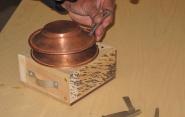Amid the High-Tech Of CEID, Coppersmith Demonstrates Centuries-Old Craft

Not far from the laser cutters and 3D printers of the Center for Engineering Innovation and Design, a seventh-generation master coppersmith gave a presentation of his craft  Thursday.
Thursday.
Bhalchandra Kadu, part of the Tambat caste that goes back generations, demonstrated the techniques of coppersmithing as they’re practiced in his home city of Pune, India. Kadu was accompanied by Professor Prasad Boradkar of Arizona State University. Together, they have been conducting research on the tradition of making copper utensils and other items from the Pune region.
As part of the demonstration, they discussed and demonstrated the technique of raising - shaping the metal into  forms - and chasing, in which the smith uses a hammer to punch in decorations. A seemingly simple candle holder can feature an intricate design made from thousands of meticulously placed hammer hits, requiring intense concentration and machinelike
forms - and chasing, in which the smith uses a hammer to punch in decorations. A seemingly simple candle holder can feature an intricate design made from thousands of meticulously placed hammer hits, requiring intense concentration and machinelike
movements honed from decades of conditioning. To get a sense of the kind of precision required, audience members were invited to take hammer in hand and try it themselves.
“This is an opportunity to bring together people from the Art Gallery, the British Art Center, the History of Art as well as the School of Engineering,” said Dr. Edward S. Cooke, Jr., the Charles F. Montgomery Professor of American Decorative Arts Department of the History of Art Yale University, who helped organize the event.
 The event was first suggested by Holly Shaffer, a Ph.D. student in the History of Art, who had done some field work in Pune.
The event was first suggested by Holly Shaffer, a Ph.D. student in the History of Art, who had done some field work in Pune.
Kadu began as a coppersmith in 1971, and worked in several factories before opening his own in 1977. Items he makes include consumer goods, such as cooking utensils. One of the things he’s best known for, though, are Temple finials – decorative structures at the top of temples. He’s one of the few people in India who can do this type of work, and people from all over the world visit his factory to see how it’s done.
Boradkar, a professor of industrial design, has been going to Pune for the past few years to learn some of the techniques from Kadu and other craftsmen there. It’s not an easy to way to make a living, Boradkar said, as the supply chain leaves little room for profit for the craftsmen. To get around this, Kadu has been acquiring his own copper and using it to create niche products that no one else is making.
“He’s tried to make it a unique business for himself, reach a broader audience for himself and therefore not be in the clutches of tradesmen, who might not be interested in his welfare but their own,” Boradkar said.

